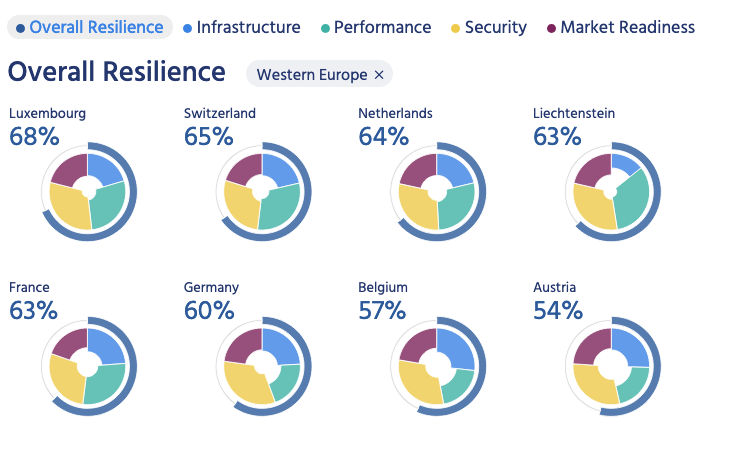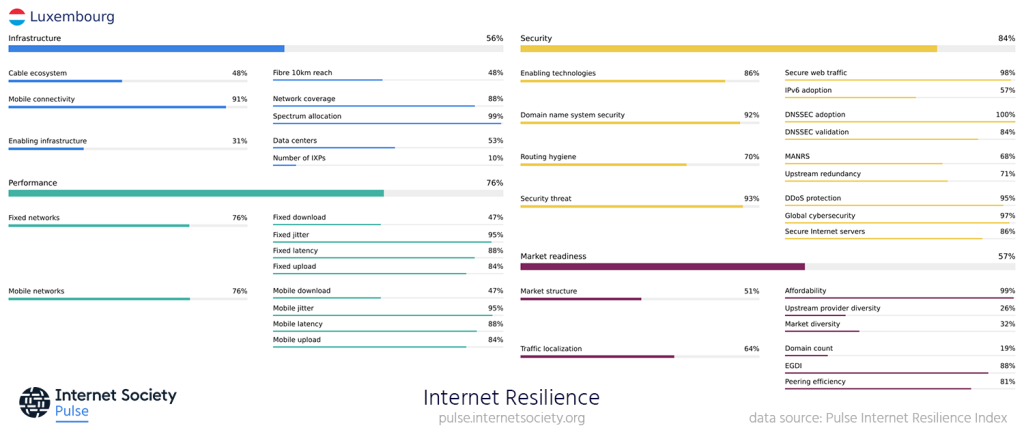- Luxembourg has one of the highest levels of overall Internet resilience in Western Europe and one of the highest globally when accounting for population size.
- Two thirds of Luxembourg’s most popular accessed content is hosted in country or in region.
- Luxembourg Internet Days is happening 19-20 November. Register now to attend.
It’s nearly time for the annual Luxembourg Internet Days event, where we’ll participate to hear from the local community and speak about Internet Society Pulse and what our data can tell us about the resilience of the Internet in Luxembourg and beyond.
Register for Luxembourg Internet Days, Luxembourg Chamber of Commerce, 19-20 November 2024
Our dependence on Internet-based services is growing constantly, but how resilient is the critical infrastructure we all depend on in the presence of deliberate attacks, natural disasters, and accidental misconfigurations? We can explore the Internet Society Pulse Internet Resilience Index to understand the dimensions of Internet resilience and see how Luxembourg measures up against other countries and regions.
What is a Resilient Internet?
Firstly let’s define terms. A resilient Internet connection maintains an acceptable level of service in the face of faults and challenges to normal operation. And Internet resilience is big business these days. A recent report found 97% of respondents said a reliable, resilient Internet is of utmost importance to their business success.
The Pulse Internet Resilience Index collates around 30 sets of public data that relate to four pillars of a resilience Internet:
- Infrastructure — the existence and availability of physical infrastructure that provides Internet connectivity.
- Performance — the ability of the network to provide end-users with seamless and reliable access to Internet services.
- Security — the ability of the network to resist intentional or unintentional disruptions through the adoption of security technologies and best practices.
- Market Readiness — the ability of the market to self-regulate and provide affordable prices to end-users by maintaining a diverse and competitive market.
The global picture (Figure 1) suggests a pretty strong correlation between a country’s Gross Domestic Product (GDP) and levels of Internet resilience, which is perhaps unsurprising.

Looking at Western Europe (Figure 2), we can see that Luxembourg has one of the highest levels of overall resilience in the region. The security, performance, and market readiness pillars are all particularly strong, and on the infrastructure pillar, Luxembourg is only in the bottom half of the eight-country region.

Reviewing each of the four pillars of Luxembourg’s Internet Resilience Index profile (Figure 3), we can see:
- Infrastructure indicators are largely positive, with the exception of Fiber reach and the Number of IXPs. I’ll discuss below the impact of weighting by population on figures like the Number of IXPs for a country the size of Luxembourg.
- Performance scores are among the highest globally — OOKLA recently ranked the country’s mobile and fixed broadband 10th and 35th globally.
- Security is similarly a strong area for Luxembourg with high scores across all indicators. Kudos also for its 57% IPv6 adoption, especially being such a small country.
- Market Readiness where, despite relatively low scores for Domain count, Upstream provider diversity, and Market diversity, Luxembourg still scores more highly than its regional neighbors.

But Weight, There’s More
If we weight measurement results by population, which seems like an entirely reasonable thing to do, then we see Luxembourg fairs even better in terms of European regional ranking scores on metrics drawn from the Pulse Country Report:
- Networks Assigned — Luxembourg moves from 32nd to 6th place.
- IPv4 Address Space Assigned — Luxembourg moves from 30th to 5th place.
- Number of IXPs — Luxembourg moves from 31st to 11th place.
- Peering Networks moves from 26th to 2nd in Europe.
This exercise makes clear that a significant enhancement we could implement in our Internet Resilience Index would be to provide the option of weighting results by population. Such weighting more clearly shows where smaller countries with naturally lower levels of infrastructure deployment are delivering extremely high levels of Internet resilience to their residents.
Where is Luxembourg’s Most Popular Content Hosted?
The chart below illustrates data gathered as part of a new Pulse Country Report feature measuring the locality of popular web content. For Luxembourg this data indicates that many large content delivery networks have a presence in both country and region today — see the Pulse Country Report for Luxembourg.
What are your thoughts or reflections on the results of our study of Internet resilience in Luxembourg? Do consider attending Luxembourg Internet Days to share your experience.
If you found this post interesting, why not review the Internet Resilience Index results for your country or region and share them with your local technical community and policymakers for discussion?
Contact the Pulse team if you have feedback or questions. With eternal thanks to the folks making Internet datasets openly available — none of this work would exist without your contributions.
Photo by Cedric Letsch on Unsplash


